Meteor Crater
Meteor Crater is a meteorite impact crater approximately 37 miles (60 km) east of Flagstaff and 18 miles (29 km) west of Winslow in the northern Arizona desert of the United States. Because the United States Board on Geographic Names commonly recognizes names of natural features derived from the nearest post office, the feature acquired the name of "Meteor Crater" from the nearby post office named Meteor.[2] The site was formerly known as the Canyon Diablo Crater and fragments of the meteorite are officially called the Canyon Diablo Meteorite.[3] Scientists refer to the crater as Barringer Crater in honor of Daniel Barringer, who was first to suggest that it was produced by meteorite impact.[4] The crater is privately owned by the Barringer family through their Barringer Crater Company, which proclaims it to be the "best preserved meteorite crater on Earth".[5][6] Despite its importance as a geological site, the crater is not protected as a national monument, a status that would require federal ownership. It was designated a National Natural Landmark in November 1967.[7]
| Barringer Crater | |
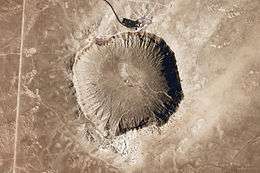 Meteor Crater, also known as Barringer Crater | |
| Impact crater/structure | |
|---|---|
| Confidence | Confirmed[1] |
| Diameter | 0.737 miles (1.186 km) |
| Depth | 560 feet (170 m) |
| Rise | 148 feet (45 m) |
| Impactor diameter | 160 feet (50 m) |
| Age | 50,000 years |
| Exposed | Yes |
| Drilled | Yes |
| Bolide type | Iron meteorite |
| Location | |
| Location | Coconino County, Arizona |
| Coordinates | 35°1′38″N 111°1′21″W |
| Country | United States |
| State | Arizona |
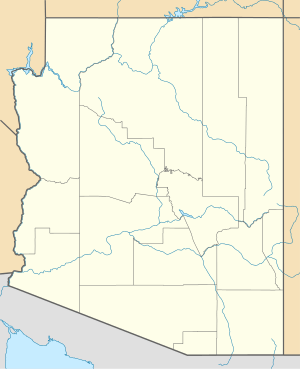 Meteor Crater Location of Meteor Crater in Arizona | |
| Access | Interstate 40 |
| Designated | November 1967 |
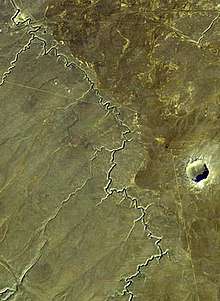
Meteor Crater lies at an elevation of 5,640 ft (1,719 m) above sea level.[8] It is about 3,900 ft (1,200 m) in diameter, some 560 ft (170 m) deep, and is surrounded by a rim that rises 148 ft (45 m) above the surrounding plains. The center of the crater is filled with 690–790 ft (210–240 m) of rubble lying above crater bedrock.[1] One of the interesting features of the crater is its squared-off outline, believed to be caused by existing regional jointing (cracks) in the strata at the impact site.[9]
Formation
The crater was created about 50,000 years ago during the Pleistocene epoch, when the local climate on the Colorado Plateau was much cooler and damper.[10][11] The area was an open grassland dotted with woodlands inhabited by mammoths and giant ground sloths.[12][13]
The object that excavated the crater was a nickel-iron meteorite about 160 feet (50 meters) across. The speed of the impact has been a subject of some debate. Modeling initially suggested that the meteorite struck at up to 45,000 mph (20 km/s) but more recent research suggests the impact was substantially slower, at 29,000 mph (12.8 km/s). It is believed that about half of the impactor's bulk was vaporized during its descent through the atmosphere.[14] Impact energy has been estimated at about 10 megatons. The meteorite was mostly vaporized upon impact, leaving few remains in the crater.[15]
Since the crater's formation, the rim is thought to have lost 50–65 ft (15–20 m) of height at the rim crest as a result of natural erosion. Similarly, the basin of the crater is thought to have approximately 100 ft (30 m) of additional post-impact sedimentation from lake sediments and of alluvium.[16] These erosion processes are the reason that very few remaining craters are visible on Earth, since many have been erased by these geological processes. The relatively young age of Meteor Crater, paired with the dry Arizona climate, have allowed this crater to remain almost unchanged since its formation. The lack of erosion that preserved the crater's shape helped lead to this crater being the first crater recognized as an impact crater from a natural celestial body.[17]
Discovery and investigation
The crater came to the attention of scientists after American settlers discovered it in the 19th century. They named it the Canyon Diablo crater after Canyon Diablo, Arizona, which was the closest community to the crater in the late 19th century. The crater had initially been ascribed to the actions of a volcano. That was not an unreasonable assumption, as the San Francisco volcanic field lies only about 40 miles (64 km) to the west.[18]

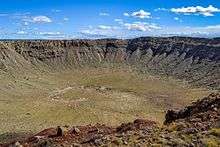
Albert E. Foote
In 1891, the mineralogist Albert E. Foote presented the first scientific paper about the meteorites of Northern Arizona.[19] Several years earlier, Foote had received an iron rock for analysis from a railroad executive. Foote immediately recognized the rock as a meteorite and led an expedition to search and retrieve additional meteorite samples. The team collected samples ranging from small fragments to over 600 lb (270 kg). Foote identified several minerals in the meteorites, including diamond, albeit of little commercial value. His paper to the Association for the Advancement of Science provided the first geological description of the crater to a scientific community.[20]
Grove Karl Gilbert
In November 1891, Grove Karl Gilbert, chief geologist for the U.S. Geological Survey, investigated the crater and concluded that it was the result of a volcanic steam explosion.[20] Gilbert had assumed that if it were an impact crater then the volume of the crater, as well as meteoritic material, should be present on the rim. Gilbert also assumed a large portion of the meteorite should be buried in the crater and that this would generate a large magnetic anomaly. Gilbert's calculations showed that the volume of the crater and the debris on the rim were roughly equivalent, so that the mass of the hypothetical impactor was missing, nor were there any magnetic anomalies. Gilbert argued that the meteorite fragments found on the rim were coincidental. Gilbert publicized his conclusions in a series of lectures.[21] In 1892, however, Gilbert would be among the first to propose that the Moon's craters were caused by impact rather than volcanism.[22]
Daniel Barringer
In 1903, mining engineer and businessman Daniel M. Barringer suggested that the crater had been produced by the impact of a large iron-metallic meteorite. Barringer's company, the Standard Iron Company, staked a mining claim to the land and received a land patent signed by Theodore Roosevelt for 640 acres (2.6 km2) around the center of the crater in 1903.[23][24][25] The claim was divided into four quadrants coming from the center clockwise from north-west named Venus, Mars, Jupiter and Saturn. In 1906, Roosevelt authorized the establishment of a newly named Meteor, Arizona, post office (the closest post office before was 30 miles (48 km) away in Winslow, Arizona).[26] This new post office was located at Sunshine, a stop on the Atchison, Topeka and Santa Fe Railway six miles north of the crater.[27]
Standard Iron Company conducted research on the crater's origins between 1903 and 1905. It concluded that the crater had indeed been caused by an impact. Barringer and his partner, the mathematician and physicist Benjamin Chew Tilghman, documented evidence for the impact theory in papers presented to the U.S. Geological Survey in 1906 and published in the Proceedings of the Academy of Natural Sciences in Philadelphia.[28]
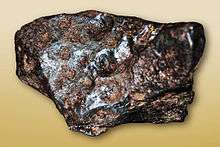
Barringer's arguments were met with skepticism, as there was a reluctance at the time to consider the role of meteorites in terrestrial geology. He persisted and sought to bolster his theory by locating the remains of the meteorite. At the time of discovery, the surrounding plains were covered with about 30 tons of large oxidized iron meteorite fragments. This led Barringer to believe that the bulk of the impactor could still be found under the crater floor. Impact physics was poorly understood at the time and Barringer was unaware that most of the meteorite vaporized on impact. He spent 27 years trying to locate a large deposit of meteoric iron, and drilled to a depth of 1,375 ft (419 m) but no significant deposit was ever found.[29]
Barringer, who in 1894 was one of the investors who made US$15 million in the Commonwealth silver mine in Pearce, Cochise County, Arizona, had ambitious plans for the iron ore.[30] He estimated from the size of the crater that the meteorite had a mass of 100 million tons.[21] The current estimate of 300,000 tons for the impactor is less than 1/300th (0.3 percent) of Barringer's estimate. Iron ore of the type found at the crater was valued at the time at US$125/ton, so Barringer was searching for a lode he believed to be worth more than a billion 1903 dollars.[30]
Despite Barringer's findings and other excavations in the early 20th century, geologists' skepticism continued until the 1950s when planetary science gained in maturity and understanding of cratering processes increased.[31] Professor Herman Leroy Fairchild, an early promoter of impact cratering, argued Barringer's case in an article in Science in 1930.[14][32]
Eugene M. Shoemaker
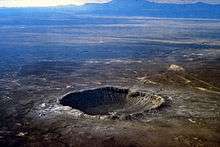
It was not until 1960 that later research by Eugene Merle Shoemaker confirmed Barringer's hypothesis. The key discovery was the presence in the crater of the minerals coesite and stishovite, rare forms of silica found only where quartz-bearing rocks have been severely shocked by an instantaneous overpressure. It cannot be created by volcanic action; the only known mechanisms of creating it is naturally through an impact event, or artificially through a nuclear explosion.[23][33] In 1960, Edward C. T. Chao and Shoemaker identified coesite at Meteor Crater, proving the crater was formed from an impact generating extremely high temperatures and pressures. The impact would have disintegrated the main body of iron mass, while the pieces of Canyon Diablo meteorite found scattered around the site, had broken away from the main body before impact.[34]
Geologists used the nuclear detonation that created the Sedan crater, and other such craters from the era of atmospheric nuclear testing, to establish upper and lower limits on the potential energy of the meteor impactor.[35]
Geology
The impact created an inverted stratigraphy, so that the layers immediately exterior to the rim are stacked in the reverse order to which they normally occur; the impact overturned and inverted the layers to a distance of one to two kilometers outward from the crater's edge.[36][37] Specifically, climbing the rim of the crater from outside, one finds:
- Coconino Sandstone (sandstone formed 265 million years ago) nearest the top of the rim
- Toroweap Formation (limestone formed 255 million years ago)
- Kaibab Formation (dolostone formed 250 million years ago)
- Moenkopi Formation (mudstone formed 245 million years ago) nearest the outer foot of the rim
Soils around the crater are brown, slightly to moderately alkaline gravelly or stony loam of the Winona series; on the crater rim and in the crater itself the Winona is mapped in a complex association with Rock Outcrop.[38]
Recent history

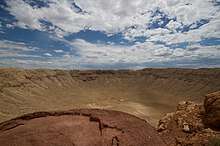
During the 1960s and 1970s, NASA astronauts trained in the crater to prepare for the Apollo missions to the Moon.[39][40]
On August 8, 1964, a pair of commercial pilots in a Cessna 150 flew low over the crater. After crossing the rim, they could not maintain level flight. The pilot attempted to circle in the crater to climb over the rim. During the attempted climb out, the aircraft stalled, crashed and caught fire. It is commonly reported that the plane ran out of fuel, but this is incorrect. Both occupants were severely injured but survived their ordeal.[41] A small portion of the wreckage not removed from the crash site remains visible.[42]
In 2006, a project called METCRAX (for METeor CRAter eXperiment) investigated "the diurnal buildup and breakdown of basin temperature inversions or cold air pools and the associated physical and dynamical processes accounting for their evolving structure and morphology."[43][44]
Meteor Crater is a popular tourist attraction privately owned by the Barringer family through the Barringer Crater Company, with an admission fee charged to see the crater. The Meteor Crater Visitor Center on the north rim features interactive exhibits and displays about meteorites and asteroids, space, the Solar System, and comets. It features the American Astronaut Wall of Fame and such artifacts on display as an Apollo boilerplate command module (BP-29), a 1,406-pound (638 kg) meteorite found in the area, and meteorite specimens from Meteor Crater that can be touched. Formerly known as the Museum of Astrogeology, the Visitor Center includes a movie theater, a gift shop, and observation areas with views inside the rim of the crater. Guided tours of the rim are offered daily, weather permitting.[45]
See also
- Barringer Medal
- List of impact craters on Earth
- Elugelab – a smaller-volume nuclear blast crater, despite being created by an object with an almost identical estimated energy release as the Barringer event, 10.4 megaton.
Notes
- "Barringer". Earth Impact Database. Planetary and Space Science Centre University of New Brunswick Fredericton. Retrieved 2008-12-30.
- "J. P. Barringer's acceptance speech." Meteoritics, vol. 28, p. 9 (1993). Retrieved on the SAO/NASA Astrophysics Data System.
- La Pas, L. (1943). "Remarks on four notes recently published by C. C. Wylie", Popular Astronomy, vol. 51, p. 341
- Grieve, R.A.F. (1990) "Impact Cratering on the Earth", Scientific American, 262 (4), 66–73.
- "Barringer Meteorite Crater * Meteorites Craters and Impacts". Barringercrater.com. Retrieved 2010-03-16.
- "Meteor Crater". Meteor Crater. Retrieved 2012-11-24.
- "Barringer Meteor Crater". US Dept of Interior, National Park Service. Retrieved 19 February 2013.
- Images of America: Meteor Crater (p. 107), Neal F. Davis, Arcadia Publishing, 2016. ISBN 978-1-4671-1618-3.
- Shoemaker, Eugene M.; Susan W. Kieffer (1979). Guidebook to the Geology of Meteor Crater, Arizona. Tempe, Arizona: Center for Meteorite Studies, Arizona State University. p. 45.
- Roddy, D. J.; E. M. Shoemaker (1995). "Meteor Crater (Barringer Meteorite Crater), Arizona: summary of impact conditions". Meteoritics. 30 (5): 567.
- Nishiizumi, K.; Kohl, C.P.; Shoemaker, E.M.; Arnold, J.R.; Klein, J.; Fink, D.; Middleton, R. (1991). "In situ 10Be-26Al exposure ages at Meteor Crater, Arizona". Geochimica et Cosmochimica Acta. 55 (9): 2699–2703. Bibcode:1991GeCoA..55.2699N. doi:10.1016/0016-7037(91)90388-L.
- Kring, David (1997). "Air blast produced by the Meteor Crater impact event and a reconstruction of the affected environment". Meteoritics and Planetary Science. 32 (4): 517–30. Bibcode:1997M&PS...32..517K. doi:10.1111/j.1945-5100.1997.tb01297.x.
- Kring, David. "Barringer Meteor Crater and Its Environment". Lunar and Planetary Institute. Retrieved 2014-02-12.
- Melosh HJ; Collins GS (2005). "Planetary science: Meteor Crater formed by low-velocity impact". Nature. 434 (7030): 157. Bibcode:2005Natur.434..157M. doi:10.1038/434157a. PMID 15758988.
- Schaber, Gerald G. "The U.S. Geological Survey, Branch of Astrogeology—A Chronology of Activities from Conception through the End of Project Apollo (1960–1973)", 2005, U.S. Geological Survey Open-File Report 2005-1190. (PDF)
- Poelchau, Michael; Kenkmann, Thomas; Kring, David (2009). "Rim uplift and crater shape in Meteor Crater: Effects of target heterogeneities and trajectory obliquity". Journal of Geophysical Research. AGU. 114 (E1): E01006. Bibcode:2009JGRE..114.1006P. doi:10.1029/2008JE003235.
- "Meteorite Crater – The shape of the land, Forces and changes, Spotlight on famous forms, For More Information". scienceclarified.com.
- McCall, Gerald Joseph Home; Bowden, A. J.; Howarth, Richard John (17 August 2017). The History of Meteoritics and Key Meteorite Collections: Fireballs, Falls and Finds. Geological Society of London. ISBN 9781862391949 – via Google Books.
- Foote, A. E (1891). "A new locality for meteoric iron with a preliminary notice of the discovery of diamonds in the iron". American Journal of Science (251): 413–417. doi:10.2475/ajs.s3-42.251.413.
- Kring, David (2007). Guidebook to the Geology of Barringer Meteorite Crater. Houston, Texas: Lunar and Planetary Institute.
- "Crater History: Investigating a Mystery". The Barringer Crater Company. Archived from the original on 31 December 2017. Retrieved 19 February 2013.
- Burke, John G. (1986). Cosmic Debris: Meteorites in History. Berkeley: University of California Press. p. 276. ISBN 0520056515.
- Oldroyd, David Roger, ed. (2002). The Earth Inside and Out: Some Major Contributions to Geology in the Twentieth Century. Geological Society. pp. 28–32. ISBN 1-86239-096-7.
- McCall, G.J.H.; Bowden, A.J.; Howarth, R.J., eds. (2006). The History of Meteoritics and Key Meteorite Collections. Geological Society. p. 61. ISBN 978-1-86239-194-9.
- Barringer, B. (December 1964). "Daniel Moreau Barringer (1860–1929) and His Crater (the beginning of the Crater Branch of Meteoritics)". Meteoritics. Meteoritical Society. 2 (3): 186. Bibcode:1964Metic...2..183B. doi:10.1111/j.1945-5100.1964.tb01428.x.
- Hoyt, W. G. (1983). "1983Metic..18..159H Page 162". Meteoritics. 18 (2): 159. Bibcode:1983Metic..18..159H. doi:10.1111/j.1945-5100.1983.tb00586.x.
- Hoyt, William Graves (1987). Coon Mountain Controversies: Meteor Crater and the Development of Impact Theory. University of Arizona Press. ISBN 9780816509683.
- Barringer, D.M. (1906). "Coon Mountain and its Crater." Proceedings of the Academy of Natural Science of Philadelphia, 57:861–86. PDF
- Smith, Dean. The Meteor Crater Story. Meteor Crater Enterprises, Inc. pp. 17–25.
- Southgate, Nancy; Barringer, Felicity (2002). A Grand Obsession: Daniel Moreau and His Crater. Barringer Crater Co.
- "Progress in Wide Search for Meteor". June 25, 1928. Retrieved 2010-07-13.
- Fairchild HL (1930). "Nature and fate of the Meteor Crater bolide". Science. 72 (1871): 463–66. Bibcode:1930Sci....72..463F. doi:10.1126/science.72.1871.463. PMID 17800007.
- Shoemaker, Eugene M. (1987). "Meteor Crater, Arizona", Geological Society of America Centennial Field Guide – Rocky Mountain Section.
- Levy, David (2002). Shoemaker by Levy: The man who made an impact. Princeton: Princeton University Press. pp. 69, 74–75, 78–79, 81–85, 99–100. ISBN 9780691113258.
- "Keyah Math – Numerical Solutions for Culturally Diverse Geology". keyah.asu.edu.
- Kring, David (2007). Guidebook to the Geology of Barringer Meteorite Crater, Arizona. Houston, Texas: Lunar and Planetary Institute.
- "Basic Stratigraphy of Barringer Meteor Crater". Department of Planetary Science, University of Arizona. Retrieved 19 February 2013.
- https://websoilsurvey.sc.egov.usda.gov/App/WebSoilSurvey.aspx
- "Apollo Lunar Training". nau.edu.
- Phinney, William (2015). Science Training History of the Apollo Astronauts. NASA SP -2015-626. p. 180,187,193,220,222,224,233–234,238,245.
- Harro Ranter. "ASN Aircraft accident 08-AUG-1964 Cessna 150 N6050T". aviation-safety.net.
- Plane Crash At Meteor Crater Revisited, September 1, 2008 Meteorite-times.com
- "University of Utah METCRAX page". Archived from the original on 2012-04-23.
- "METCRAX". utah.edu.
- "admissions - Meteor Crater". Meteor Crater. Retrieved 2018-01-16.
External links
| Wikimedia Commons has media related to Barringer Crater. |
| Wikivoyage has a travel guide for Meteor Crater. |
| Wikisource has the text of the 1920 Encyclopedia Americana article Crater Mound, Arizona. |
- Barringer Crater official site
- Meteor Crater Visitor Center – official site
- USGS Meteor Crater Sample Collection – historical documents, interactive map and sample requests

- Impact Meteor Crater Viewer Google Maps Page with Locations of Meteor Craters around the world
- CNN: New computer analysis shows that the meteor may have been traveling more slowly than previously thought
- Computer generated movie based on satellite imagery and topography data
- Aerial Exploration of the Barringer Structure
- Geologic Map of the Eastern Quarter of the Flagstaff 30ʹ x 60ʹ Quadrangle, Coconino County, Northern Arizona United States Geological Survey
- Herman Leroy Fairchild: An Early Promoter and Defender of Meteorite Impact Cratering – includes details of early investigations into Meteor Crater
- 3 Dimensional stereoscopic image pair of the Barringer Crater by Volkan Yuksel (arranged for crossed-eye viewing technique)
- Guidebook to the Geology of Barringer Meteorite Crater, Arizona (a.k.a. Meteor Crater)
- "Mine Shaft is Sunk to Solve Meteor Mystery" Popular Mechanics, January 1930
- Milwaukee Sentinel - Dec 14, 1941 Metal in Arizona Meteorite may solve defense problem US Govt. considered mining nickel from the crater for the war effort.



